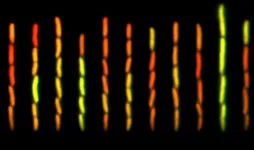Could a gene regulatory network in gut microbes have evolved its elaborate and tightly regulated molecular machinery only to pump out antibiotics indiscriminately? Researchers from the Institute of Science and Technology Austria (ISTA) show this is an auxiliary function. By maintaining basal levels of genetic activity when the network is in its OFF state, these genes ensure the bacteria remain fit and adaptable to their highly variable environment in the gut. The findings were published in PNAS.
This is the story of a misnomer. And an immense and intricate molecular machinery at that, tightly regulated like a Swiss watch. Or is it? The mar network of genes was discovered and named in the context of multiple antibiotic resistance. At the same time, it is one of the most complex gene regulatory networks in gut bacteria known to date, featuring an intricate interplay of genes that turn it on or off. Additionally, it shows “leaky” pulsatile gene function when it is supposedly switched off. So, how did such a high-tech piece of engineering come to exist in a commonplace organism, and why does it “leak” despite being tightly regulated?
A team of researchers at the Institute of Science and Technology Austria (ISTA) led by former postdoc Kirti Jain and Professor Calin Guet demonstrated a surprising key function for the mar system—when the gene network is supposed to be switched off. Its pulses roughly overlap with the hosts’ feeding cycles, thus helping the microbes grow and adapt to their constantly changing environment in the gut. “We do not know of another mechanism that got selected on the OFF state,” says Guet, highlighting the findings’ surprising aspect.
Leaky activity or functional relevance?
The mar system is well-studied in the gut bacteria Escherichia coli, undoubtedly due to its role in multiple antibiotic resistance, from which it got its name. Yet, despite being tightly regulated, it still exhibits a measurable level of pulsatile expression in its OFF state. “This observation appears counterintuitive,” says Jain, the study’s first author. “If the mar system evolved under a strong selective pressure to be tightly controlled, why does it still allow for low-level basal expression? Should it not ensure that target downstream genes are activated only when needed? Could this basal expression serve an adaptive role or have a functional relevance?” This paradox motivated Jain, Guet, and their collaborators at ISTA to address these fundamental questions about the evolution and function of basal gene expression in the mar system.
Tight regulation and a rare “start” signal
Especially in the context of gene regulation, basal gene expression is often overlooked. This is because a higher focus is set on the ON or OFF states of genetic networks rather than the nuances of low-level expression. “Working on the mar system, I came to appreciate its intricate regulatory mechanism. I was particularly interested in the fact that its most studied function, antibiotic resistance, is just one aspect of this elaborate molecular clockwork,” says Jain. Thus, together with Guet, Senior Staff Scientist Robert Hauschild, Professor Gašper Tkačik, and other colleagues at ISTA, she set out to understand the mar system’s function beyond antibiotics.
One unique aspect of the mar system is the first transcription start signal it carries, the code that kick-starts genetic activity. This so-called “start codon” has an unusual GTG code (guanine-thymine-guanine), less commonly found in the DNA of bacteria and other organisms. However, this unusual code is conserved in all gut microbes alongside E. coli at the start of their mar systems. Suspecting that this unusual start codon plays a role in the mar system’s pulsatile activity in its OFF state, the team mutated it to other start codon sequences. By doing so, they found that this seemingly trivial genetic modification significantly altered the mar system’s expression, increasing or decreasing it considerably. On the other hand, the rare start codon in the wild-type bacteria made the expression pulses roughly correspond to the patterns of the host’s food intake. These pulses of genetic activity in the OFF state helped the gut microbes adapt their growth to their changing environment by outcompeting those that did not pulse. “Our results reveal that the choice of different start codons can be a highly effective genetic knob for fine-tuning the dynamics of complex gene regulatory networks,” says Jain.
Pumps and auxiliary functions
Having pinpointed the molecular mechanism that likely gave the mar system an evolutionary fitness advantage, the researchers argued that this allowed auxiliary functions to evolve. Such auxiliary functions include activating giant and elaborate molecular ‘pumps’ to flush out antibiotics from gut bacteria. Previous reports suggested these pumps probably evolved as a protective mechanism to flush out any toxins ingested by the host. In fact, these pumps are not very discriminative in their action, as they recognize a widespread molecular structure found in many organic molecules. Such a function is very ‘expensive’ for the microbes to maintain. Thus, having it as the mar system’s primary function would be deleterious for the gut bacteria’s resources, i.e., their fitness and survival.
The present study sheds a new light on the systems that govern antibiotic resistance and could thus help scientists develop novel therapeutic strategies for effective public health measures. In addition, it supports the earlier suggestion whereby the mar system might be more about ‘multiple adaptational responses’ Rather than ‘multiple antibiotic resistance.’ “As a main takeaway from this project, I’d like to highlight the importance of asking fundamental yet overlooked questions and reexamining observations in light of technological advancements,” says Jain. “I am happy that Calin gave me the chance to explore such questions and supported me and the project against all odds. Also, having Robert and Gašper with their cross-disciplinary expertise on board reshaped how I approached the analysis. Such collaborations highlight the diverse and interdisciplinary research at ISTA.”
END


